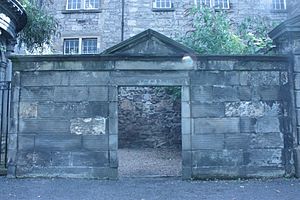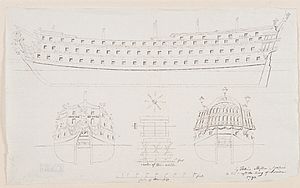Patrick Miller of Dalswinton facts for kids
Patrick Miller of Dalswinton (1731–1815) was a smart Scottish banker and a clever inventor. He was also an owner in the Carron Company, which made engineering parts. Miller is buried in a special tomb in Greyfriars Kirkyard in Edinburgh.
Contents
Early Life and Education
Patrick Miller was born in Glasgow. He was the third son of William Miller of Glenlee. He went to the University of Glasgow. After finishing his studies, he chose to work in banking. This was a good choice because the Scottish economy was growing a lot back then.
A Career in Banking
In November 1760, Miller joined forces with William Ramsay of Barnton. They were merchants and bankers in Edinburgh. In 1767, he was chosen to be part of the leadership at the Bank of Scotland.
Miller made many important changes at the bank. One big change was making it easier for banks to accept money notes from other banks. This helped the bank stay strong during a money crisis in 1772. His ideas helped the bank succeed. Later in his life, he became a top leader at the Bank of Scotland.
Inventing and Sea Adventures
Patrick Miller often traveled by sea to look after his business interests. On these trips, he saw how dangerous privateers (pirates working for governments) could be. These experiences made him very interested in cannons and designing ships. He spent a lot of his time thinking about how to make ships better and safer.
Designing a Warship
Miller tried to get different navies in Europe interested in his idea for a super warship. Only Sweden showed much interest. Their famous ship designer, Chapman, even called it the "English sea-spook."
Miller sent a real test ship, called Experiment of Leith, to the Swedish king, Gustav III. As a thank you, the king sent Miller seeds of the swede plant. These seeds came in a beautiful snuff-box with pictures of ships on it. This special box is now in a museum in London.
Paddle Boats and Steam Power
Miller was very interested in boats with more than one hull. These boats used paddle wheels between the hulls, turned by hand cranks.
He saw a model of a steam-powered carriage made by an engineer named William Symington. Miller then asked Symington to put his steam engine into a two-hulled boat. This boat was successfully tested on Dalswinton Loch near Miller's house on October 14, 1788.
The next year, a bigger engine was put into a 60-foot-long, two-hulled paddle boat. This boat was tested on the Forth and Clyde Canal. There were some problems at first, like the paddle wheels breaking. But on December 26 and 27, 1789, the boat traveled a good distance along the canal. Miller eventually stopped working on this project because it was becoming too expensive.
The Charlotte Dundas
About ten years later, Lord Dundas helped restart Symington's work on steam-powered boats. This led to the creation of the famous paddle steamer called the Charlotte Dundas.
Images for kids







